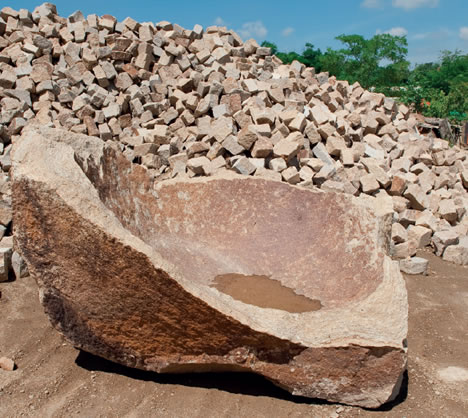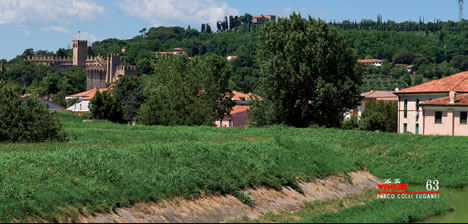CLAUDIO GRANDISStorico
Strappando ai colli la pietraTRACHITEL'attività dell'uomo ha creato, con questo materiale, parte della pavimentazione delle calli veneziane
|
|
Piantata sulla terra anfibia della laguna, Venezia ha attinto sin dal suo sorgere alle risorse della Terraferma. Tralasciando i boschi di conifere e le macchie planiziali di rovere, abbattuti per alimentare l'insaziabile Arsenale, dobbiamo qui ricordare gli innumerevoli pali usati nelle fondazioni, la calce dei leganti cementizi, l'argilla destinata alle fornaci, la bianca pietra di Rovigno per gli ornamenti architettonici, ma ha impiegato soprattutto la trachite euganea, la masegna, o sasso vivo, come sovente ricordano memorie e documenti. Estratta sin dall'antichità, come provano le steli funerarie preromane del Museo Nazionale Archeologico di Este, la pietra vulcanica si è rivelata nel tempo la migliore e la più adatta per i basamenti di molti edifici e, a partire dal XV secolo, la più idonea ad arginare, lungo i litorali di Sottomarina e di Pellestrina, i marosi dell'Adriatico. La cava per eccellenza fu soprattutto il colle di Lispida, sfruttato già sul finire del Medioevo: i padri del locale monastero di Santa Maria non a caso furono spodestati delle loro proprietà dal governo della Serenissima interessato ad un maggior sfruttamento delle priare. Non lontano da Lispida, furono le basse collinette dell'Archino e del Pignaro ad essere assalite da schiere d'affamati cavatori, armati spesso di solo piccone. Dal Canal delle Piere la trachite veniva imbarcata e tradotta a valle di Rivella, all'Acquanera. Qui veniva trasbordata sui burci, barche più capienti, verso gli approdi della laguna.
Placed on the amphibious land of the lagoon, Venice drew since its origin from the Mainland resources. Leaving out the conifer woods and the oak plain scrubs, which have been felled to "feed the insatiable" Arsenal, it is important to remember the innumerable poles used for the foundations, the lime of the cement binder, the clay for kilns, the white stone of Rovigno for the architectural ornaments, but above all the euganean trachyte, the "masegna" or living stone, as memories and documents often remind. Extracted since antiquity, as proved by the pre-Roman funerary steles of the Archaeological National Museum of Este, the volcanic rock turned out to be the best and the most suitable for the basements of several buildings and, from the XV century, the most appropriate to embank, along the coasts of Sottomarina and Pellestrina, the large wave of the Adriatic Sea. The quarry par excellence was above all the hill of Lispida, already exploited at the end of the Middle Age: it was not a case that the fathers of the monastery of Santa Maria were dispossessed of their properties by the government of La Serenissima, mostly interested to a large exploitation of the "priare". Not too far from Lispida, the low hills of Archino and Pignaro were attacked by a crowd of hungry quarriers, often armed with only a pick. From the Canal of the Piere, the trachyte was taken on board and sent to Rivella, at the Acquanera. Here, it was transhipped on the "burci", larger ships, and directed to the lagoon landing. They went back and forth for centuries, except when, occasionally, extraordinary events occurred, such as for example floods, or in case of lack of means of transport. During the XVIII century the trachyte has been more and more used to pave "calli" and fields, small squares and shores of the lagoon city, such as San Marco square and Riva of the Schiavoni. It was an exploitation that, during the XIX century, had relevant dimensions with disastrous effects for the slopes. The hills which surrounded Monselice changed their shape and their outline, in particular the Hill of the Rocca and the southern side of Mount Ricco. Among the several owners of those quarries we cannot forget to mention the Cini family – just that related to the San Giorgio Island that gives its name to the Foundation – which made its fortune extracting and trading with trachyte. Other quarriers shipped the euganean rock along the shores of the Zattere and of the Fondamenta Nuove: Girardi, Corinaldi, Pamio, Bonetti, Lazzaro, Trevisan and Dalla Francesca, all scattered with their operations centres along the Euganean Riviera of the Battaglia canal.
|
|
VITICOLTURA >>>>>
Potete ordinare la vostra copia del "Parco dei colli euganei" online oppure lo trovate in edicola e potrete godervi le immagini ad alta risoluzione. Contattateci per eventuali richieste.
 |
Le Tre Venezie Editoriale Via Zermanese 161, 31100 Treviso, tel e fax: +39 0422 404807 |




